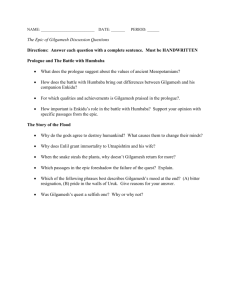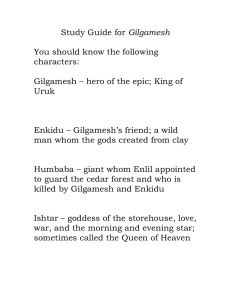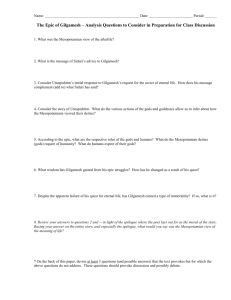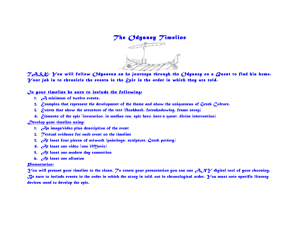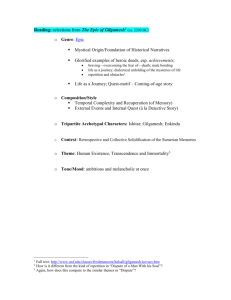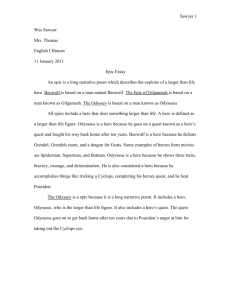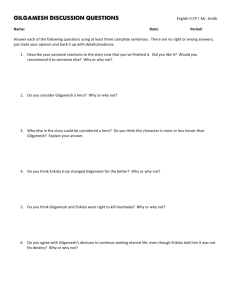Epic Poetry: Gilgamesh, Heroes, and Archetypes
advertisement
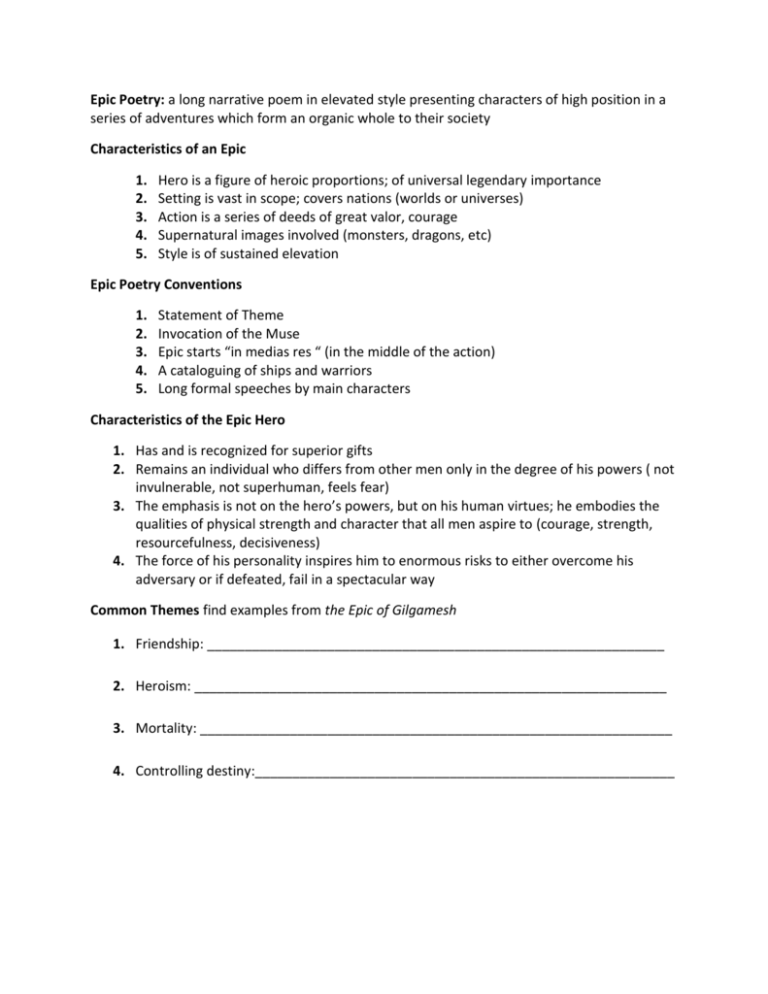
Epic Poetry: a long narrative poem in elevated style presenting characters of high position in a series of adventures which form an organic whole to their society Characteristics of an Epic 1. 2. 3. 4. 5. Hero is a figure of heroic proportions; of universal legendary importance Setting is vast in scope; covers nations (worlds or universes) Action is a series of deeds of great valor, courage Supernatural images involved (monsters, dragons, etc) Style is of sustained elevation Epic Poetry Conventions 1. 2. 3. 4. 5. Statement of Theme Invocation of the Muse Epic starts “in medias res “ (in the middle of the action) A cataloguing of ships and warriors Long formal speeches by main characters Characteristics of the Epic Hero 1. Has and is recognized for superior gifts 2. Remains an individual who differs from other men only in the degree of his powers ( not invulnerable, not superhuman, feels fear) 3. The emphasis is not on the hero’s powers, but on his human virtues; he embodies the qualities of physical strength and character that all men aspire to (courage, strength, resourcefulness, decisiveness) 4. The force of his personality inspires him to enormous risks to either overcome his adversary or if defeated, fail in a spectacular way Common Themes find examples from the Epic of Gilgamesh 1. Friendship: _____________________________________________________________ 2. Heroism: _______________________________________________________________ 3. Mortality: _______________________________________________________________ 4. Controlling destiny:________________________________________________________ Understanding an Archetypal Battle An archetype is a pattern or theme that recurs in many different cultures. One common archetype is the struggle between the forces of good and evil. In the Epic of Gilgamesh, this battle is waged between Gilgamesh and Enkidu, who represent the forces of good and light, and the giant Humbaba, who embodies the forces of evil and darkness. Present-day evidence of this archetype can be seen in movies such as Star Wars, in which the forces of good, as represented by Luke Skywalker, are pitted against the forces of evil, as represented by Darth Vader. Whether archetypal characters are on the side of good or of evil is often revealed by how they are described or how they appear. In Star Wars, Luke, the agent of light and good, wears white; the evil Darth is clothed in black. In The Epic of Gilgamesh, Enkidu’s description of Humbaba makes it clear that the giant is allied with the forces of evil. Likewise, the description of Gilgamesh reveals qualities associated with light and goodness. Read the following descriptions. While these quotations are not from the archetypal battle scene, they do reveal the archetypal pattern of good and evil. On the lines provided, tell whether the character described is on the side of good or of evil. Then write a few sentences to explain your answer. 1. “He was wised, he saw mysteries and knew secret things…Adad, the god of storms, endowed him with courage, the great gods made his beauty perfect, surpassing all others…” _____________________________________________________________________ _____________________________________________________________________ _____________________________________________________________________ _____________________________________________________________________ _____________________________________________________________________ 2. “…between them stood I before an awful being, the somber-faced manbird…His was a vampire face, his foot was a lion’s foot, his hand was an eagle’s talon.” _____________________________________________________________________ _____________________________________________________________________ _____________________________________________________________________ _____________________________________________________________________ _____________________________________________________________________ Understanding the Hero and His Quest A hero’s quest is a theme common to the folklore and literature of many cultures. This quest is always for something of great value, be it something tangible, such as a lost object or a missing person, or something intangible, such as knowledge or fame. In the case of Gilgamesh, the quest is for immortality. Regardless of what is being sought, it is customary for the hero of a quest to encounter dangerous obstacles during the course of the search. These obstacles often require the hero to endure great suffering, which, once overcome, leads to fulfillment of the quest. Think about fictional characters either from literature or from the movies who have journeyed on a quest. Then read the items that follow. Write your responses on the lines below (you may not use any Star Wars movie/ character for your example). 1. Identify the character or characters and describe their quest. __________________________________________________________________ __________________________________________________________________ __________________________________________________________________ __________________________________________________________________ 2. In what way is the quest similar to and/or different from the quest of Gilgamesh? __________________________________________________________________ __________________________________________________________________ __________________________________________________________________ __________________________________________________________________ 3. Why do you think the quest theme has been and still is so popular today? __________________________________________________________________ __________________________________________________________________ __________________________________________________________________ __________________________________________________________________
